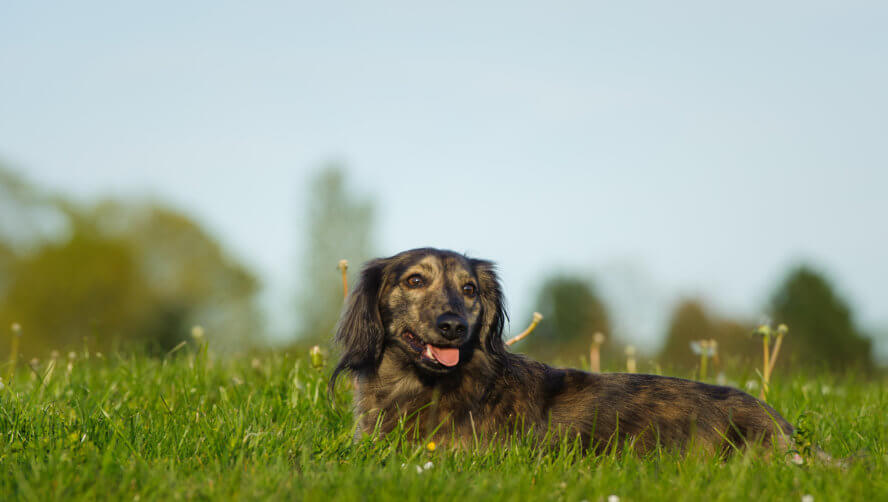The Brindle dachshund is a beautiful and instantly recognisable hound grace to its unique coat pattern.
Brindle is one of many varieties of the traditional wiener dogs, yet their distinguished look sets them apart from the rest of the dachshunds’ family.
They share all the same characteristics with the other dachshunds; the difference is that Brindle doxie has that “tiger striped” patterned coat.
It is just impossible to find two identical brindle dachshunds, making each of these doxies one of a kind.
This article takes a close look at the brindle dachshund focusing on their physical appearance and genetics behind the brindle pattern.
It also discusses whether Brindles are predisposed to any health problems, and finally advises on how to choose a brindle dachshund puppy.
The best way to help your dachshund live longer?
Watch our video to find out!
What Is a Brindle Dachshund?
The Brindle dachshund is merely a dachshund with the stripes. It displays the unusual zebra-like pattern, which sets it apart from other wiener dogs. The Brindle wiener dog is indeed a real eye-catcher.
Brindle is not a typical pattern in dachshunds, unlike in other breeds such as Boxers for instance.
Though the kennel clubs began the Brindle dachshunds recognition at the turn of the 20th century, the brindle pattern is still not considered as one of the primary colours displayed in the shows.
As mentioned earlier, you won’t see many Brindle dachshunds since it is quite challenging to produce the puppies with distinct Brindle markings.
In addition to these marks on dachshunds, you may also notice brindle pattern present on other animals. These include guinea pigs, cattle, some lizards, many different dog types, and even horses.
What Causes the Pattern in Dachshunds? (Genetics)

At least seven different genes are responsible for the various coat colours in Dachshunds. Brindle is the dominant gene. That means that one parent must be a Brindle to produce a Brindle puppy.
This specific gene is the cause of the black of chocolate strips to appear on any dachshund’s pigmented areas. It is usually seen on red, tan or cream base coat colours.
Brindle gene causes a random distribution of stripes on the dachshund’s body. Stripe width can vary considerably, and it is not known which genes, if any, are in control of this variation.
According to the science of genetics, Brindle is the result of the mutation in the K Locus.
There are three versions of genes based in the K locus, and one of these makes the dog brindle. Brindle is, therefore, dominant over the default coloration, that is yellow, while recessive to the black gene.
A light base coat on a brindle is generally due to the Intensity locus, which dilutes red pigment to cream, but does not affect black pigment.
The dominance of this gene also means that you could quite possibly breed a solid colored dachshund, which does not carry Brindle, with a dachshund that shows brindle stripes. This breeding can result in a litter of pure brindle dachshund puppies.
Unlike with Dapples, you can also breed pure brindle dachshunds, and it won’t result in any genetically linked disorders.
In fact, by mating two brindles together, you increase your chances of producing higher quality brindle dachshund puppies in regards to their pattern.
What Do Brindle Dachshunds Look Like?

The brindle dachshund undoubtedly looks stunning. The exotic, striped pattern in dachshunds is considered quite rare.
To be registered as Brindle, the dachshund has to have some pattern present. Whatever shape and colour the striping pattern is, and whatever base colours it is present over, there should undoubtedly be a patterning of some form.
Furthermore, the Brindle pattern should also be dark in colour and either visible on the dachshund’s main body or in its tan points.
Long or wiry fur can obscure brindle markings. Therefore, the stripes will be less distinct in long haired and wire haired dachshunds.
The most common Brindle dachshunds are the red ones. However, you’ll also find black and tan dachshunds with brindle stripes present in their tan points.
It also applies to the chocolate and tan dachshunds as well as the dilute coloured ones.
Though the rule of thumb is that visible striping of some sort should be present on a brindle doxie, there are many variations possible.
Often you may hear this striping referred to as tiger-striped, merely because it can at times resemble a tiger’s coat.
However, this striping is much more subtle than the one visible on the big cat’s fur.
The streaks of colour present on a brindle sausage dog will certainly be irregular and most likely darker than the coat base colour.
On some light Brindle dachshunds, there may be substantial red areas where the stripes are “missing.” The genetics of that patterning is unknown.
Potential Health Problems

Fortunately, there are no specific genetic health problems associated with the Brindle pattern.
However, the Brindle dachshund is still susceptible to the general health issues of a dachshund kind. Therefore, it is always helpful to be aware of common dachshund health problems, that include:
- Intervertebral Disease
- Patella Luxation
- Hip Dysplasia
- Hypothyroidism
- Gradual Loss of Vision
- Cancer
- Urinary Tract Infection
- Obesity
Most of these conditions can be managed or prevented. First of all, make sure that your brindle dachshund doesn’t become overweight as it puts additional strain on the spine.
Secondly, don’t encourage your doxie to jump on the furniture or climb the stairs, as it also has a negative impact on the spinal cord.
Finally, be mindful at all times of the way you hold your dachshund. Try to support its spine constantly. Prevention is the key to avoid the number one genetic condition in dachshunds – Intervertebral Disc Disease.
If you would like to read more about the dachshund’s health issues and how to prevent them, click here.
If you’re keen on purchasing a Brindle dachshund puppy, then give yourself some time to do your research and see at least a few breeders. It’s always good to ensure that you get the best puppy from the litter.
When choosing a brindle dachshund puppy, we suggest looking for certain aspects, including:
1. Make sure that you see the puppy’s parents. A reputable breeder should have no qualms about showing you the dam and the sire of the puppy. If only one parent is available, find out whether it is possible to visit the other as well.
2. Request the puppy’s paperwork. The purebred dachshund puppies should be automatically registered by a breeder at a Kennel Club, allowing you to trace back their lineage.
Furthermore, if you want to be sure that the litter you are currently viewing is indeed Brindle, this paperwork will be helpful.
3. Ask the breeder to see any evidence of vet records. A responsible breeder should be in regular contact with the vet and have already done a checkup and vaccinations of the puppy.
4. Take your time to observe how the puppy socialises with the rest of the pack and its mother. The puppy should display a healthy behaviour. Ideally, it should play with the other puppies from the litter, but without being overly aggressive while socialising.
5. Do a physical examination when you pick up and hold the puppy in your arms. Check for any visible signs of health issues, paying attention to the teeth and gums, and also the eyes and the ears.



Comments
I bought a long hair brindle and black, not planning on breeding him but he sure is cute
Can i breed a Brindle with brindle
Yes, absolutely!
Can you breed a brindle to a chocolate dapple
Could you please let me know. Thank you
Hi Julia, we advise against breeding dachshunds with different coat patterns, because the breed standards do not allow to register the dogs with mixed patterns. It does not mean that the mixed patterned dachshunds do not exist or that they are unhealthy. But we are striving to avoid confusion in the industry and promote ethical breeding.